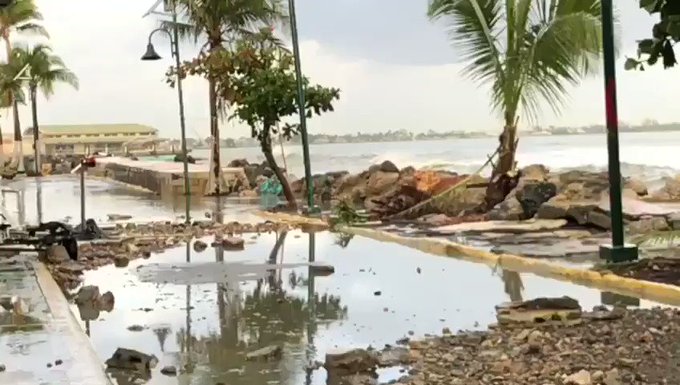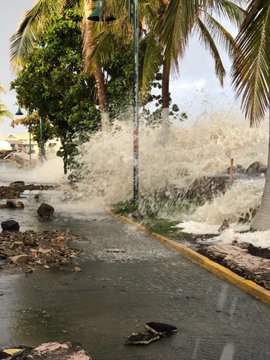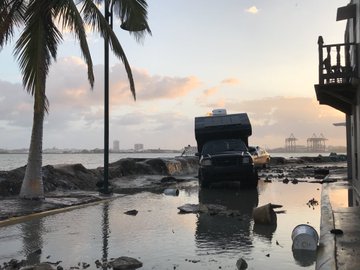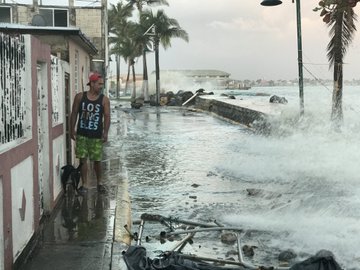Once the hurricane moved on, an all-too-common aftermath unfolded. Local emergency responders became overwhelmed. There was, memorably, public fighting among political officials -- San Juan’s mayor versus President Trump. Relief agencies and volunteers flooded in. People who wanted to help could find long lists of organizations to donate to, though, as is typical after a disaster, it wasn’t clear where the money was best spent. Dollars often flowed indiscriminately.
Ten days after the hurricane, a different kind of responder arrived on the island. His name was Jesse Levin, a 32-year-old serial entrepreneur with close-cropped hair and aviators, and the co-founder of a series of rock-climbing gyms called Brooklyn Boulders. He had no military background, though he had volunteered in past disaster zones and spoke the language of relief -- casually discussing “air assets” and “force multipliers.” Before he arrived he’d made plans to help, help that didn’t necessarily involve the cluster of government agencies and NGOs that were scrambling to advance their operations. “It was mind-boggling,” he recalls now. “There was just completely ineffective communication going on.”
A rented jeep was waiting for him.
Once in Puerto Rico, Levin spent several days crisscrossing the island’s debris-strewn roads, talking to residents, business owners, mayors and policemen. He rarely came across an aid worker or a utility truck. In the media, he’d kept hearing that people were desperate for food and water. But in village after village, Levin encountered grocery stores open and stocked with enough provisions to sustain the local communities. Enterprising merchants had even rustled up generators to keep on the lights. But many customers couldn’t buy anything: Around 40 percent of Puerto Rico’s population depends on food stamps, which require Electronic Benefit Transfer (EBT) cards to make purchases. With the island’s telecommunications network down, the cards couldn’t be processed. This particular problem didn’t require an intensive governmental effort to distribute food and water. It was just a connectivity issue that nobody else was solving.
So Levin coordinated with Steve Birnbaum, a satellite communications expert he works with, who had arrived on the island a week before the hurricane to prep for the storm’s aftermath. Their plan: to personally buy a bunch of small satellite terminals from Focused Mission, an emergency response business on the island. Levin then worked some local government contacts until he wrangled a helicopter. Among them was Puerto Rico’s chief information officer, Luis Arocho, who came along for a beta test to see if their plan would succeed. Soon this small team was airborne and installing terminals on two grocery store rooftops. They flipped the switches and boom -- EBT purchases now worked. Levin would go on to install 12 more.
The experience was validating. “If the economy is broken in a place, the location can’t heal,” Levin says. But now, functioning EBT machines can lead to more products sold, more employees paid and more shelves restocked -- an economic system revived, and saved from further dependence on FEMA aid. He says the hard costs totaled $33,000, which was ultimately reimbursed by the Foundation for Puerto Rico, and that around $3 million in transactions have since passed through the satellite terminals.
But it was legitimizing on a far larger level as well. Levin isn’t here in Puerto Rico simply to do one-off projects like this. He’s here to advance a concept -- an audacious idea that he calls “expeditionary entrepreneurship.” In essence, it’s disaster relief in the form of entrepreneurship. Governments and NGOs are important, he says, with their standard operating procedures and approaches to administering aid. But entrepreneurship -- not profiteering, but the principles of entrepreneurship -- can accomplish what those bodies cannot: quick and nimble responses to ground-level problems, and connective tissue between foreign aid resources and capable local actors like grocery store merchants who are often not engaged. The same instincts that help an entrepreneur build a business, in other words, can help them rebuild a region from catastrophe.
Levin explains this to me as we drive past toppled power lines and landslide debris in Puerto Rico’s lush interior mountains. It is mid-January, four months after the storm has passed. “An entrepreneur looks at systems and comes up with creative fixes,” he says. “We start from the bottom up.”

Image Credit: Andy Isaacson
Levin didn’t just dream up “expeditionary entrepreneurship” one day. Instead, he came to it after pursuing two parallel paths: He was an adventurer, and an entrepreneur.
He’s always had an entrepreneur’s sensibility -- that ability to sniff out an opportunity and boldly claim it. As a middle schooler in Connecticut, he launched a guerrilla marketing company called Jesse Levin’s Adrenaline Marketing. (Slogan: “With all due respect, you need a kid.”) He talked the beverage company SoBe into paying him $15,000 and helped promote them at extreme sports events by dyeing his, his friends’ and even his dog’s hair the brand’s hue of green.
During summers, meanwhile, he also attended wilderness survival classes, learning how to build shelters and track animals through the woods. He became captivated by the power of resourcefulness -- how solutions exist all around us. “Survival school informed every facet of my life,” Levin says. “My relationships, how I see things, how I conduct my business.”
After graduating from Babson College in 2007, those two passions continued apace. He moved to Panama, got into real estate, eventually bought a farm, and then launched a consulting firm. A Dutch company hired him to do project management and cultural mediation work in a remote coastal area where it had acquired land. The area -- a haven for narcotraffickers and local mafia -- was prone to flooding, and Levin inadvertently became the go-between for the special maritime police and the Red Cross to deliver medical care and supplies to his local community. The experience got him interested in disaster relief, so he followed the typical path: He volunteered. Following the historic earthquake in Haiti in 2010, he joined the NGO Hope for Haiti and spent six months crawling around the rubble. After the 2013 typhoon in the Philippines, he split his time between Manila and a town named Tacloban, where he worked alongside Team Rubicon, a relief organization made up of veterans.
Amid these overseas excursions, he was also pursuing traditional entrepreneurship. He became co-founder of Brooklyn Boulders, a New York climbing gym that was expanding into new cities. The first location was just outside Boston, and Levin’s goal was to draw people to the space. He realized that the same principles he’d learned in Haiti and the Philippines -- drop in with no agenda, assemble a capable operational team and work closely with locals to find culturally relevant solutions -- could work here as well. “We found the bike builders, the finger painters, the VCs and the nonprofits, and as we built, we said, ‘Here’s our philosophy: How can you leverage this space to amplify what’s going on here locally?’ ” Soon the place became a hybrid gym/community center/co-working space, hosting drone races, TEDx events and nude drawing classes, with MIT engineering students mingling with graffiti artists. Levin would replicate the concept in Chicago, and sell most of his stake in 2016.
Throughout this period, starting in 2010, he also launched and ran a company called Tactivate, which pitches itself as a project manager inspired by the strategies and tenets of Special Operations. Through his disaster work, Levin had befriended many Air Force pararescuemen and Army Ranger types. He found them to be inherently entrepreneurial, but their resourcefulness, wide-ranging capabilities and “operational mentality” often went unappreciated in the civilian world. Tactivate could bridge that divide, he reasoned, by combining military veterans with what its website describes as “installation artists, hospitality gurus, bootstrap entrepreneurs, branders” and more, for whatever project needs doing.
That’s turned out to include running events, art installations and a “pop-up outdoor survival training bar” in Miami. His parallel life pursuits had begun to bleed together, each informing the other. In entrepreneurship, he was channeling disaster relief -- the idea of moving quickly, identifying needs and bringing people together. In disaster relief, he’d been applying entrepreneurship -- dropping into post-disaster environments and creatively supporting local capacity.
Along the way, Levin had assembled a vast Rolodex of relief operatives, from medics, communications specialists and private pilots to people involved in emergency logistics and air freight transport. “We all just kind of team up and see how we can fix things,” he says. “We’re fixers.” By last year, he’d come up with the phrase “expeditionary entrepreneurship” as a way to formalize his approach to disaster relief. Now he wouldn’t just be freelancing his way through regions; he’d be enacting a named strategy, which he could communicate to others.
Andy Isaacson

After Hurricane Maria savaged Puerto Rico, a man named Jesse Levin used what he'd learned as an entrepreneur and applied it to disaster relief. And it worked.
How Entrepreneurship Is Helping to Save Puerto Rico






